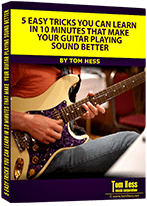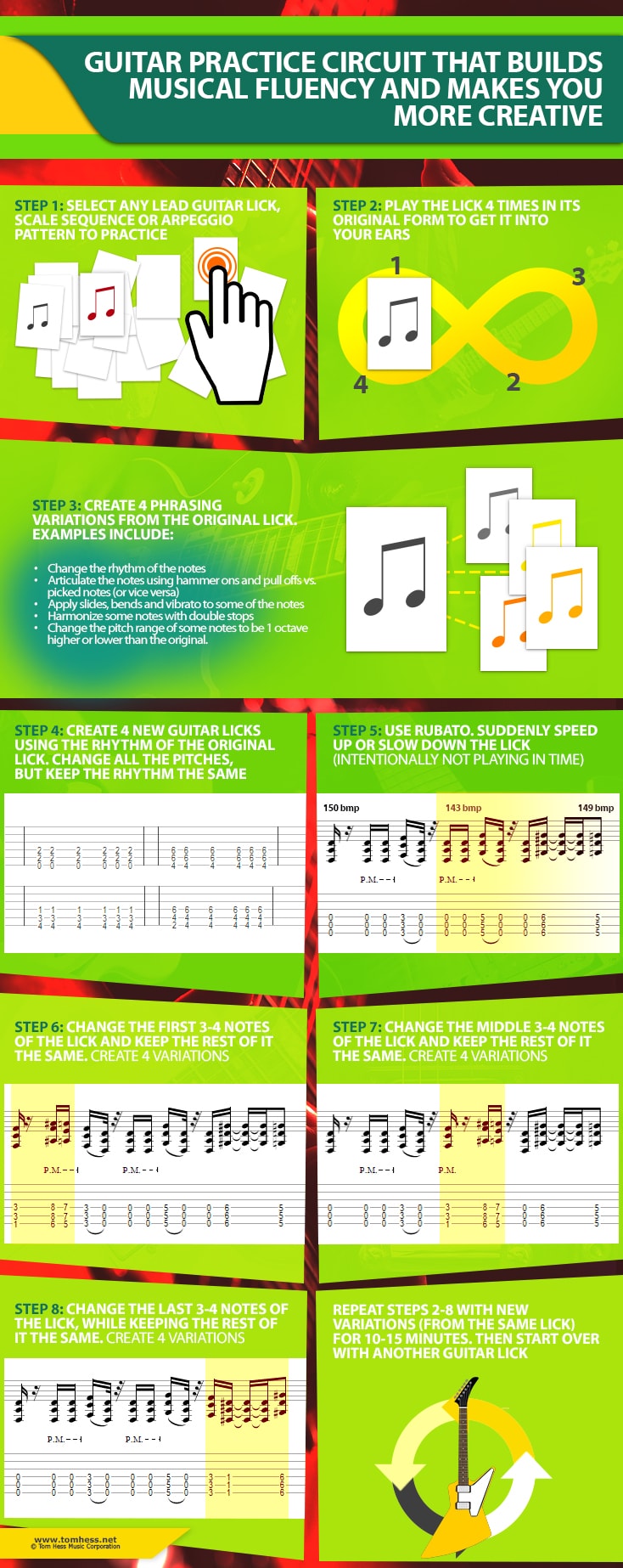Guitar Practice Strategy That Improves Your Musical Creativity & Makes Guitar Practice Fun
By Tom Hess
Learn In 10 Minutes

EMAIL TO GET ACCESS
By submitting your info, you agree to send it to Tom Hess Music Corporation who will process and use it according to their privacy policy.
It's not as hard as you might think.
To increase your creativity, work on integrating your musical skills in a fluent way during your guitar practice.
What does integration mean?
Integration is about:
- Combining a skill (or guitar technique) with other musical skills, techniques or concepts.
- Practicing being creative with the musical skill you are learning.
You can practice integration long before you've mastered something in isolation.
Learn In 10 Minutes

EMAIL TO GET ACCESS
By submitting your info, you agree to send it to Tom Hess Music Corporation who will process and use it according to their privacy policy.
Want to see an example?
No problem...
Check out this video to see a killer guitar lick made using a guitar practice strategy for integrating arpeggios and scales together:
Question: “But Tom Hess, how does one use the guitar practice strategy of “practice being creative” on guitar? Can you really improve this during guitar practice, or is it something you have to be born with?”
Answer: Musical creativity can be trained and improved by anyone when you use the right guitar practice strategy. Creativity is a byproduct of mastering specific skills and integrating them. Integration practice is key to being a creative guitar player.This guitar practice circuit helps you integrate your musical skills together:

Do these steps one after the other without stopping.
Step 1: Select any lead guitar lick, scale sequence or arpeggio pattern to practice.
Step 2: Play the guitar lick 4 times in its original form to get it into your ears.
Step 3: Create 4 phrasing variations from the original guitar lick.
For example:
- Change the rhythm of the notes.
- Articulate the notes using hammer ons and pull offs vs. picked notes (or vice versa)
- Apply slides, bends and vibrato to some of the notes.
This free guide shows you many examples of creating phrasing variations with guitar licks.
Step 4: Create 4 new guitar licks using the rhythm of the original lick. Change all the pitches, but keep the rhythm the same.
Step 5: Use rubato. Suddenly speed up or slow down, intentionally not playing in time. This video shows many examples of how to do rubato phrasing on guitar.
Step 6: Change the first 3-4 notes of the guitar lick and keep the rest of it the same. Create 4 variations.
Step 7: Change the middle 3-4 notes of the guitar lick and keep the rest of it the same. Create 4 variations.
Step 8: Change the last 3-4 notes of the guitar lick, while keeping the rest of it the same. Create 4 variations.
Repeat steps 2-8 with new variations (from the same guitar lick) for 10-15 minutes. After 15 minutes, start over with another guitar lick.
 Practice Less To Get More Results
Practice Less To Get More ResultsBecome highly effective with your guitar practicing time.
 Create A Guitar Practice Schedule
Create A Guitar Practice ScheduleLearn 8 steps to creating your own guitar practice schedule.
 Powerful Guitar Practicing Secrets
Powerful Guitar Practicing SecretsDownload a free 100+ page eBook
with guitar practice tips.
Tips For Going Through This Guitar Practice Circuit:
- Select a practice item that is simple enough to play cleanly. This frees your mind to think about creativity and fluency and not become distracted by sloppy playing.
- Do your best to not stop between each step. Move from one step of the circuit to another as quickly as possible. This develops your fluency and creativity much faster. Keep track of the time you have to spend thinking about each variation and try to reduce that time. This is one of the ways to measure progress with fluency and integration.
- Make a list of creativity and fluency elements you struggle with the most. For example: you may discover that you struggle to play rubato and have a limited arsenal of guitar phrasing ornaments to create variations with.You now know what skills to focus on to make integration (and creativity) easier.
Frequently Asked Questions:
Question: “Tom Hess, What if I don’t know how to create variations from arpeggios?”
Answer: Here are 2 simple ideas:
- Create unexpected rests (silence) in the middle of the arpeggio (instead of playing all notes of the arpeggio in a predictable rhythm).
- Vary the number of strings used in your arpeggio licks. An arpeggio is simply a chord consisting of 3, 4 or 5 notes, repeated in different octaves. Changing the pitch range of the arpeggio makes your lick sound more creative.
Question: “Tom Hess, how should I best combine this circuit training with the rest of my general guitar practice strategy?”
Answer: Schedule time to train your fluency the same way you schedule time for practicing any other musical skill. Having an effective guitar practice strategy and a schedule ensures that you make time for all skills you need to work on to reach your goals.
Think of this guitar practice strategy as a test of your fluency and integration skills. you can practice this circuit 1-2 times per week to test yourself. The rest of the time should be focused on improving your skills, so you can become more creative.
This free lead guitar practice guide shows you many examples of creating phrasing variations with guitar licks.
Need help with your guitar practice strategy? Get better results from your guitar practice with a rock and metal guitar teacher online.

